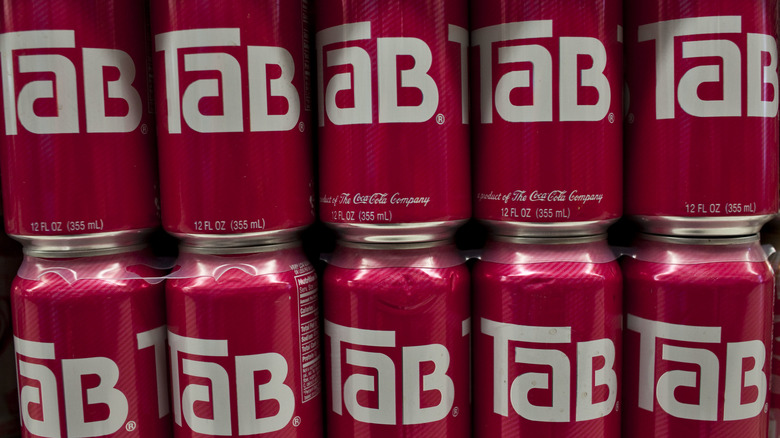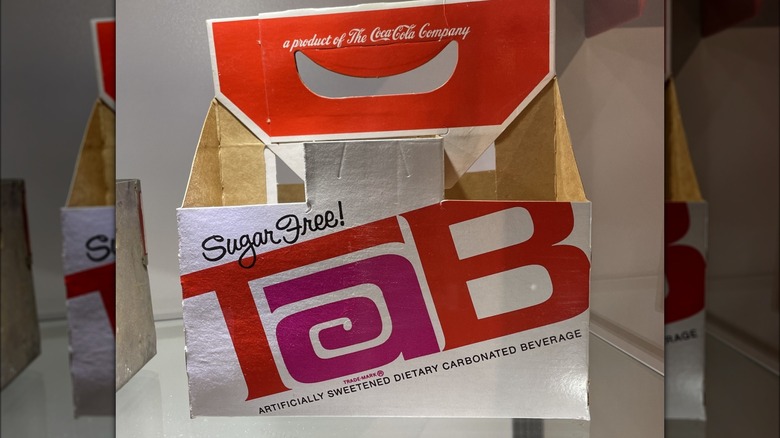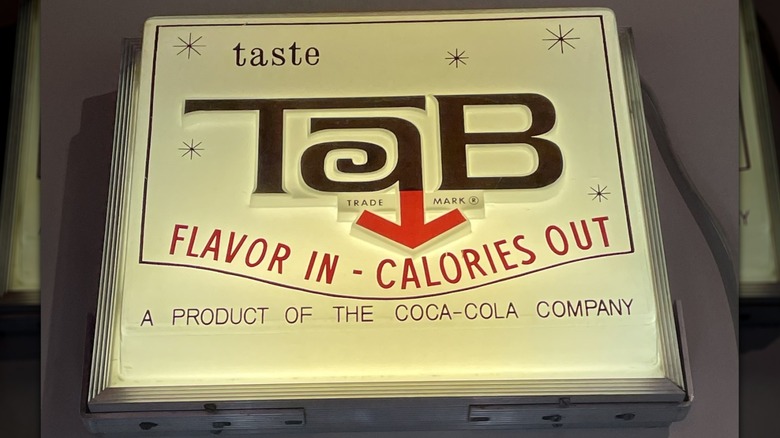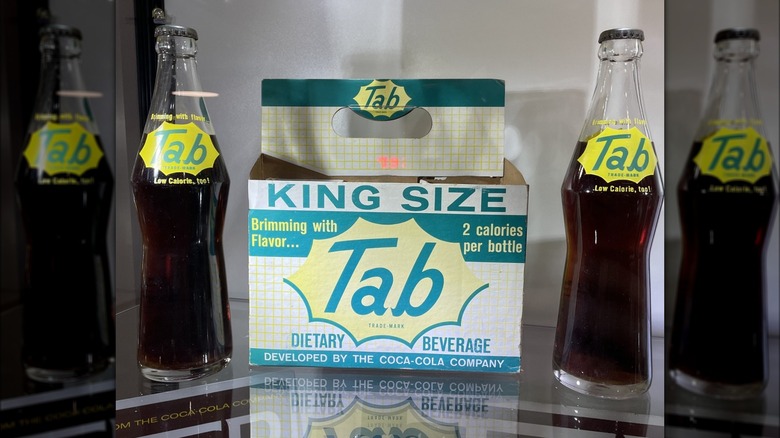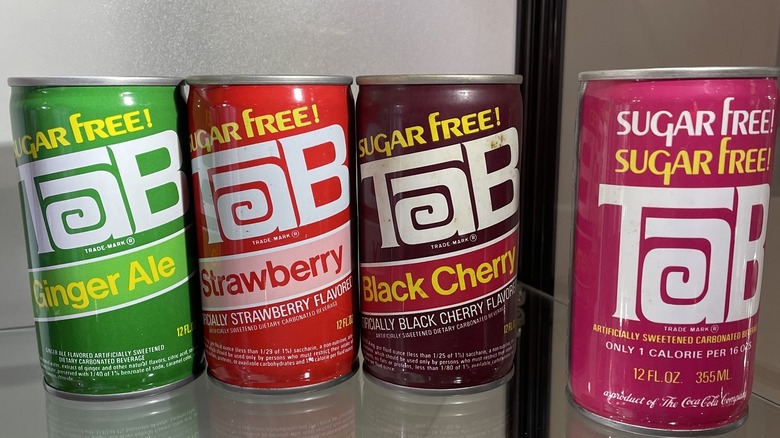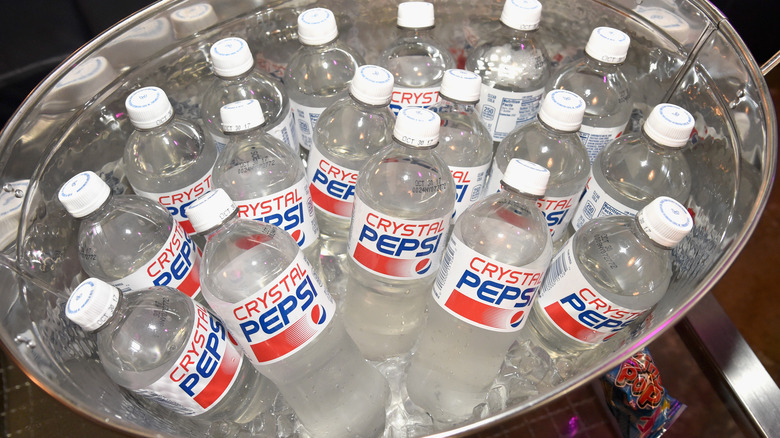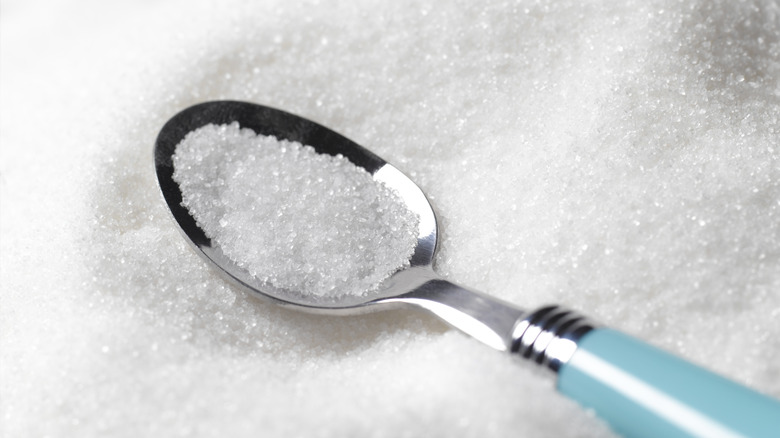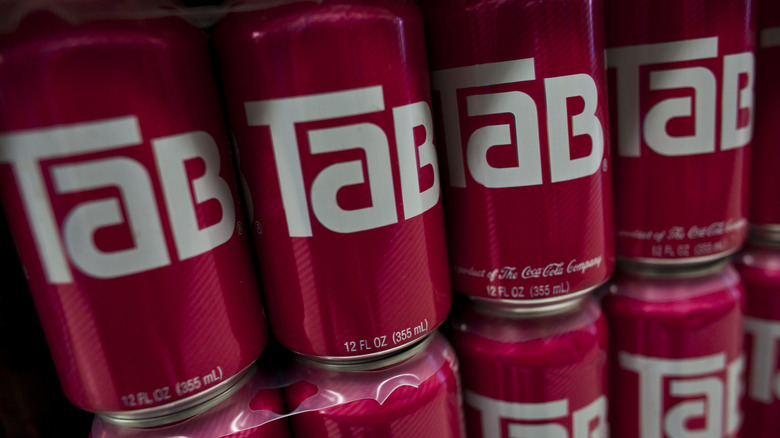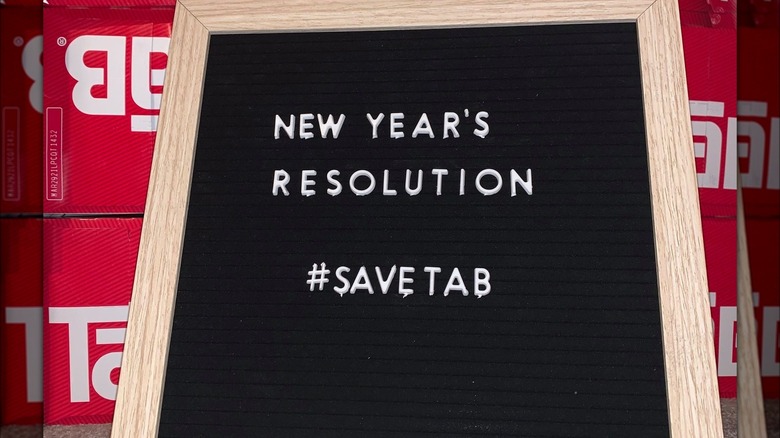The History Of TaB And Why It Was Discontinued
How does a drink go from being one of the most popular sugar-free sodas on the market to being totally discontinued? Well, this is what happened to TaB. One of the first diet drinks ever available on supermarket shelves, TaB was once beloved by many. But over the years, its fanbase dwindled until the drink was finally discontinued by Coca-Cola. Now, those who want to have a sip must hunt it down on auction sites in the far corners of the Internet. Soon, it will have disappeared entirely.
TaB must have tasted pretty good to spark its cult-like following that still searches for the drink, even after all these years — especially when the soda had a cancer-causing ingredients scare! Whether you are TaB's #1 fan, thought it was gross, or never even got to have a sip, we've gone behind the scenes of all TaB's science, marketing, fan campaigns and more. This is the real history of TaB and why it was finally discontinued.
TaB was Coca-Cola's first diet drink
While the space race to the moon caught America's attention in the 1960s, there was another competition happening in the background: The race for the best diet soda. While sugary drinks were nothing new in the States, an alternative soda for the health conscious had never been on the market — until now. In 1962, Coca-Cola threw its hat into the research and development ring, eager to out-sell competitors like Diet Rite who were already testing out the market. The company's aptly-named "Project Alpha" had one goal. To create the best diet soda and get it on supermarket shelves by 1963. And so TaB was born. Right on time, the soda hit the scene with an advertising campaign boasting "How can just 1 calorie taste so good?" This was to set the soda apart from competitors' options, which might have also been low-calorie, but had a bitter aftertaste that most didn't like.
This product launch set the scene for Coca-Cola's continued success. "We're forever grateful to TaB for paving the way for the diets and lights category, and to the legion of TaB lovers who have embraced the brand for nearly six decades," said Kerri Kopp, group director, Diet Coke, Coca‑Cola North America said in a 2020 press release about the drink's discontinuation. "If not for TaB, we wouldn't have Diet Coke or Coke Zero Sugar. TaB did its job." That job was to get the Coca-Cola company to the forefront of the diet soda market.
Why was it called TaB?
There are a lot of different theories around what TaB might actually stand for. There have been rumors circulating for years that as the first diet soda on the market, that the drink's name stands for "totally artificial beverage." Other's think that it must be for those who wish to keep "tabs" on their weight, due to its synthetic sweeteners and lack of real sugar. The brand acknowledged these that these guesses played a part in the naming of the drink with nods to them in different advertising campaigns through the years. However, none of them are the final reason behind the names development.
The truth can be found within well-circulated story about how a computer helped name the drink. Those in charge of research and development for Coca-Cola in the 1960s were playing around with their new computer, an IBM 1401. They asked the machine to come up with a list of four-letter words that had at least one vowel in them. It spit out over 185,000 options for them to choose from. However, the marketers thought that most of the names were too weird, too hard to say, or sounded a bit too much like something that was already on the market. Once the list was significantly narrowed down, "Tabb" was voted as the winner. It was eventually changed to TaB later on down the line, and styled as such by the bottle's designer.
Coca-Cola designed a new bottle for the soda
Because TaB was the company's first entry into the diet soda market, it wanted to do something a little bit different with the packaging design. In a May 1963 issue of Atlanta Magazine, the Coca-Cola company revealed that it tasked Robert Sidney Dickens of Chicago with the job. Dickens needed to create packaging which told the public that not only did TaB taste great, but it was also great for you. The only catch is that since the soda would be going out with distributors to existing machines and markets, its dimensions couldn't vary much from the original Coke bottle. Dickens took on the task, also stylizing the drink as "TaB" instead of "Tab" or "tab" in the process.
"At the time we were thinking in terms of a slim sleek package, something that would say low-calorie, less weight — that sort of thing," Dickens told Atlanta Magazine, as reported by Beach Branding & Packaging Design. "But research showed that people instinctively thought of a low calorie drink as flat, thin, lightweight, lacking in flavor." To avoid this interpretation, the original glass bottle was given lots of textured design. These bumps and stars were to make the glass look more exciting, and not flat and boring as many consumers might assume a diet soda to be.
What did TaB taste like?
Since you can no longer buy TaB (save for a few random corners of the Internet with old cans for auction), many might wonder what it actually tasted like. However, the reports of the soda's taste and appeal online vary greatly. TaB super fan Adam Burbach told Bon Appétit that there is a reason for this. "It's very hard to describe. We've all been trying to find a substitute for it and there's no other soda that tastes like it," he said. "It's probably the closest thing to the original Coca-Cola classic formula, but without all the calories. Diet Coke does not taste like Coca-Cola, Coke Zero does not taste like Coca-Cola. But TaB tastes very similar."
The reasoning behind this, shared by many fans of the soda, is because the flavor profile of TaB was so unique. "If it was a wine, you'd say its flavor profile is very strong," another TaB-lover Jenny Boyter told Atlanta Magazine. "It's definitely not a boring pinot." She went on to tell the outlet that she thinks it has a bit of a kick to it, while other drinkers think it had a touch of citrus to the flavor.
TaB came in other flavors throughout the years
While the first and classic TaB flavor was reminiscent of modern-day Diet Coke or Coke Zero, the soda actually came in many other flavors over the years, too, however short lived. There was a lemon-lime version of TaB that many believe was Coca-Cola doing a bit of market research before introducing Sprite Zero years later, although this is an unconfirmed rumor. There was also the likes of TaB Black Cherry, TaB Strawberry, TaB Root Beer, Tab Ginger Ale, and TaB Orange. By the end of the 1970s, however, most of these alternative TaB flavors had been discontinued and only the original flavor remained.
Yet in the decades to come, the company did put forward other variants, too. There was a caffeine-free version of the drink, plus a short-lived TaB energy drink in 2006, as well. However, as Coca-Cola turned its advertising and production focus onto its more popular soda brands like Coke and Sprite, these flavor options fell off the shelves, out of the public eye, and eventually into obscurity.
The soda was primarily marketed toward women
In its retirement announcement for the soda, Coca-Cola noted that, as its first ever diet drink, it marketed TaB mainly towards women. Throughout the 1960s, 70s, and 80s, advertisements for the brand really leaned into the angle of gendered marketing. One advertisement for the soda shows a slender woman in a bikini, subtly implying that those who enjoy TaB might look just like her one day. Another shows a glass full of the fizzing drink cinched in at the middle, mimicking the smaller waist that drinking one-calorie TaB might give you. These ads are both subtle and explicit in their meaning all at once, which really encapsulates the insidious pressure of diet culture at the time.
Journalists who have studied the drink's impact on pop culture insist that putting TaB forward as "the beautiful drink for beautiful people," and running campaigns like "TaB's got sass" and "Body by TaB," all with slim, classically beautiful women in little clothing at the forefront, cement its place in toxic diet culture history. Others may argue that these advertisements were simply a product of their time. However, one campaign that really stands out — and not in the best way — is the "Mind Sticker" TaB campaign. It told women to drink the soda to "stay in his mind with a shape he can't forget." The commercial goes on to indicate that men prefer their female partners to stay in shape, and that TaB is the best way to achieve this.
TaB created a clear version to sabotage Pepsi
Most of the time, when a company introduces a new product, it does so for profit and brand awareness. However, when Coca-Cola decided to launch a clear version of TaB in December 1992 the company only had one thing on its mind: Sabotage. Its biggest rival, Pepsi, had just introduced Crystal Pepsi. This drink was basically the same as the original soda with one big difference: the fact that it was clear. While the sales numbers were not crazy for the drink, they were just high enough that they were a threat to Coke. So the company fought back, even though it knew its clear drink might not make a splash.
"It was a suicidal mission from day one," Coca-Cola chief marketing officer Sergio Zyman told author Stephen Denny for his 2011 business book, Killing Giants. "Pepsi spent an enormous amount of money on the [Crystal Pepsi] brand and, regardless, we killed it." This is because the market at the time was small for the clear sodas, but regardless, because there were two options for consumers, it was split. Because of this, both drinks eventually failed and were pulled from the shelves,making Crystal Pepsi just another discontinued Pepsi flavor. Yet to Coca-Cola, this was considered a big win!
It contained an ingredient that caused a cancer scare
The main selling point of TaB was that it was a sugar-free soda. Instead of using the traditional methods, it was sweetened with artificial alternatives, like calcium saccharin and aspartame. The drink was one of the most popular on the market in the 1970s and 80s because of this, only for Coca-Cola to significantly pull back on promoting the drink when saccharin was publicly linked to bladder cancer. This also put a lot of consumers off the soda, too, due to the fear of getting sick. For some drinkers, TaB's reputation would never recover, because as the years went on, many people only continued to think diet soda had big health risks.
However, this panic was actually based on false information. The reason for the scare was a misunderstanding of the results of the original studies. It turns out that, yes, scientists did find that ingredients like saccharin and cyclamate seemed to be creating bladder cancers in some instances in rats. Yet when performed on humans, these results of these experiments did not stay the same as no cancer or precancerous cells were developing. Because of this, they concluded that saccharin and cyclamate are not carcinogens, or substances that can cause cancer. Unfortunately, for many consumers, the damage to TaB's reputation had already been done.
Why was TaB finally discontinued?
TaB's eventual downfall seems is due to a crowded diet soda market. With so many options, Coca-Cola wanted to stop competing with itself. So it decided to streamline its offerings. By getting rid of TaB, the brand could consolidate what it sold and make room in its lineup for new sodas, too. "In order to continue to innovate and give consumers the choices they want today, we have to make decisions like this one as part of our portfolio rationalization work," Kerri Kopp told TaB fans in a press release. "This is not a bottom-line efficiency play," Brad Spickert, senior vice president, innovation and commercialization, Coca‑Cola North America, added when speaking of TaB's retirement. "It's a top-line growth play."
The company cutting the soda as if it was dead weight was not surprising to many fans. This is because TaB hadn't been presented as an option in advertising for nearly 40 years before its eventual discontinuation. "They could have actually advertised it," fan Trish Priest told Bon Appétit. "TaB hasn't been advertised since Diet Coke came out in 1982." Jenny Boyter, another enthusiast of the soda, signaled her agreement: "Like Trish said, it feels like there's been zero advertising. I can't believe a product has been sold for decades with no advertising." TaB fell out favor with the company long before its eventual retirement, as Coca-Cola had chosen to focus on other things like the famous polar bears for its main brand instead.
TaB has passionate fans who are dedicated to bringing it back
Whether or not TaB will ever again grace supermarket shelves is yet to be seen. While it might be unlikely, as the soda was all but abandoned by Coca‑Cola in advertising years before its retirement, there is a group of passionate fans out there who see things very differently. In October 2020, when Coca‑Cola officially announced the drink's discontinuation, a few die-hard fans of the drink banded together to form the SaveTaBSoda Committee. The group started a Change.org petition to restart production. It is currently sitting at over 7,000 signatures.
Members credit their love of the soda for their passion for the cause, and they're willing to rally behind their favorite drink for as long as it takes. A different group of fans managed to revive Surge, another former Coca-Cola product, which has given TaB fans hope that they might have a chance at success, too. To show how dedicated they are, members of the organization have even traveled to company headquarters in Atlanta to make their voices heard. "TaB has a special place in the hearts of so many," Adam Burbach, president of the movement said in a press release. "We're traveling to Atlanta with hopes that our stories will encourage Coca-Cola to bring back this iconic product that has meant so much to its fans. The brand affinity for TaB is strong and we would love to be able to purchase and enjoy it again."
